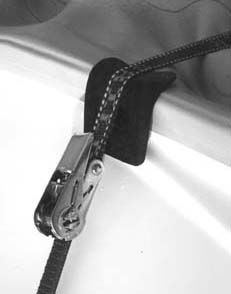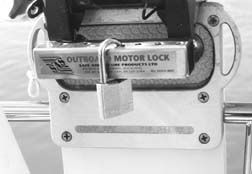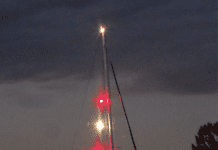We Americans sometimes think that we have all the best answers, but it ain’t necessarily so. New Zealand and Australia both have dynamic marine industries that sometimes come up with better products than are commonly found in the US. Remember, after all, that these are the only two countries that have managed to take the America’s Cup away from America!

Both of these products are simple, obvious solutions. Unfortunately, neither is imported into the US, although they should be. Anyone interested in getting into international trade on a small scale?
Aerofast Ratchet Tie-Downs
The design isn’t new. Ratcheting load securers can be purchased in practically any marine store in the US. What’s different is that Aerofast’s tie-downs have a stainless steel ratcheting device, rather than the plated steel usually found in the US. Plated steel parts are fine for use on trailers, but don’t make it for regular use in a saltwater environment.
And just how do you use ratcheting tie-downs on a cruising sailboat? The obvious answer is for securing a dinghy on deck.
We carry our AB rigid bottom inflatable upside down over our small forward deckhouse, securing straps to folding Wichard padeyes on deck. In the past, we used nylon webbing secured with a variety of hitches to try to hold the dinghy in place against the force of waves breaking over the foredeck, but we were always a little uneasy about whether or not things were tight enough.
With ratcheting tie-downs, we have the opposite problem: knowing when to stop cranking on the ratchet before we break the dinghy.
We bought the Aerofast Tie-Downs in New Zealand, where they are manufactured, for about $25 a pair. The set included two ratcheting buckles and 2,000-pound nylon straps, with stainless steel S-hooks in the ends of the straps. You can also buy just the stainless steel ratchets, making up your own straps.
The S-hooks are not the right solution, as they can catch lines or chafe the dinghy. We are replacing them with stainless steel carabiner-type hooks without protruding edges. At the same time, we will cut the webbing to the proper length, so that there’s not a bunch of excess strap to secure. (Aerofast Tie-downs Ltd., 580 Wairakei Rd., PO Box 140155, Christchurch 5 , New Zealand; 64 3 358 8991, fax: 64 3 358 8931.)
SAS Outboard Motor Lock
Unfortunately, outboard engine theft is a serious problem for cruisers everywhere. It’s not a problem limited to the Third World. A good friend had a new 8-hp. Yamaha taken off his stern rail in Newport Harbor.

For the last three years, we’ve used a Master Lock outboard motor lock, which obviously works, as we still have our outboard. But after three years in saltwater, the vinyl-coated steel channel of the Master Lock is peeling and rusting, even though it is still structurally fine.
In New Zealand, we found a conceptually similar product in stainless steel. Manufactured by Safe and Secure Products, the SAS Outboard Motor Lock is fabricated of interlocking pieces of stainless steel channel, which slip over the tightening handles of your outboard motor. Security is provided by a nickel-plated Master lock with a stainless steel shackle.
While the SAS padlock is more exposed to attack than the special brass padlock used in the Master Lock fitting, its stainless steel shackle should be tougher than the brass shackle of the Master Lock. The stainless channels of the SAS lock adjust to fit tightly over a variety of handle sizes, making it hard to pry off.
At about $48 US in New Zealand, the SAS Outboard Motor Lock is a lot more expensive than the Master Lock outboard motor lock, which goes for about $22 in US chandleries. However, the stainless steel SAS lock will look better for a longer time while keeping your outboard secure. (Safe and Secure Products Ltd., PO Box 42122 Orakei, Auckland, New Zealand; 64 9 529 5978, fax: 64 9 529 5286.)








































